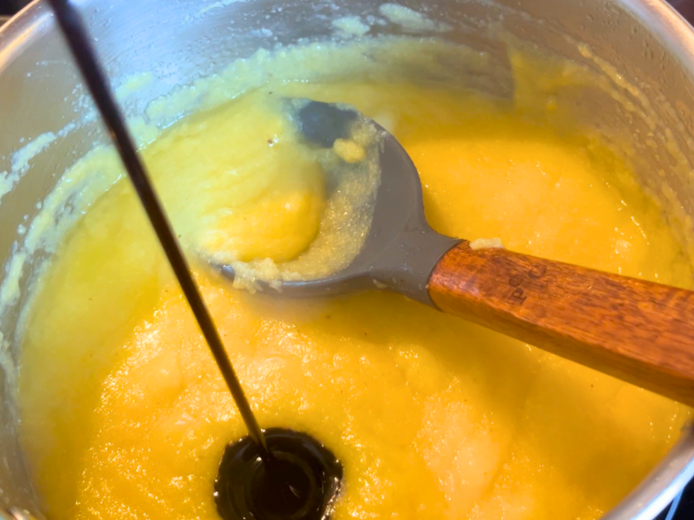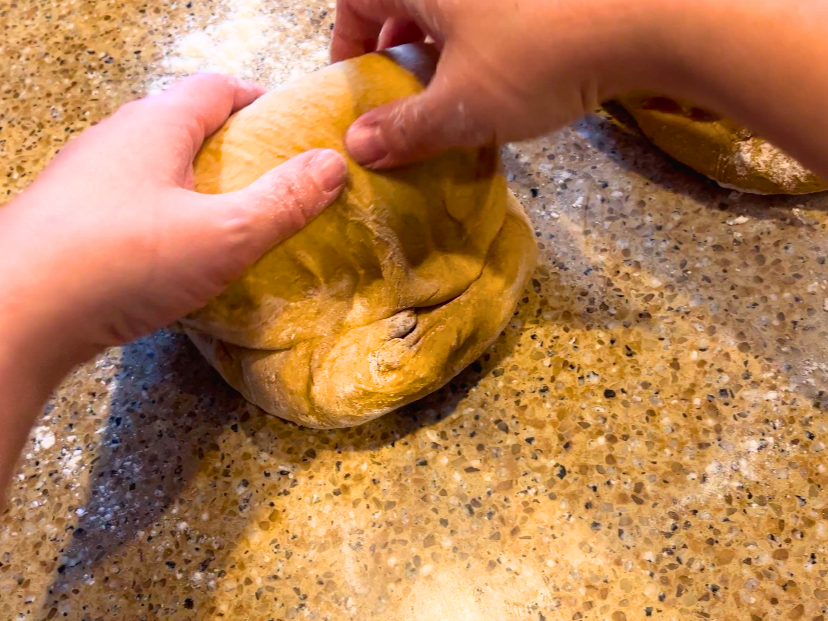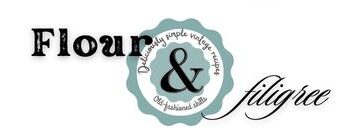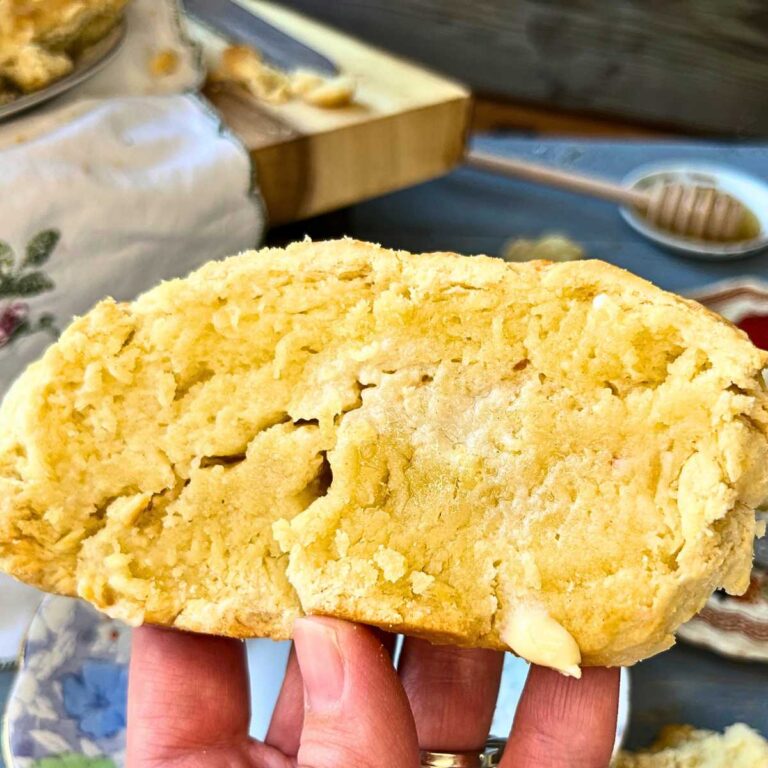Old-Fashioned Cornmeal Molasses Brown Bread
By Rebecca St.Clair
Jump to RecipeIf you are a molasses fan, you are going to love cornmeal molasses brown bread. I recently made a similar bread recipe using oats, Old Fashioned Oatmeal Molasses Brown Bread, and let me tell you this cornmeal bread is just as good! It is super soft, tender, and moist. The flavour, oh my, so delicious! The molasses adds so much to this bread recipe!

Using this uniquely flavoured bread for just about everything you would use normal everyday sandwich bread. The flavour is different but not overpowering. We love using it for Monte Cristo sandwiches, grilled cheeses, and as a perfect accompaniment for eggs in the morning!
Molasses
Molasses can be a bit confusing. There are different types of molasses and each type will impact the taste of your recipe. You really shouldn’t substitute one for the other.
Molasses is a byproduct of the sugar making process. Fancy molasses is from the first boiling and has a light and sweeter flavour. Blackstrap molasses is from the third boiling. It is bitter and much stronger in flavour.
That being said, which one to choose! Where I live there are two types of molasses, fancy molasses and blackstrap molasses. Fancy molasses is sometimes also called light molasses and blackstrap is sometimes called dark molasses. In other areas there may be different grades of molasses and different names.
Fancy molasses or light molasses is almost always used in baked goods, like bread and gingerbread cookies.
Blackstrap molasses is bitter and is used in cooking things like baked beans, when you want a strong smoky flavour.
So, now you know the reason behind which type of molasses should be used for which recipes. I am going to be sticking with fancy, or light, molasses for this recipe!
Why do we add molasses to bread
I have found that many vintage recipe call for molasses. I would suggest that this would be due to cost. Since molasses is a byproduct of the sugar making process, it was much less expensive than buying white sugar. This may be one of the main reasons molasses was used so much more in vintage recipes. I find the deep caramel, and almost smoky flavour notes, that molasses brings to baking, to be much richer than using white sugar.
That being said, there are a few different qualities molasses adds to bread, and baking in general.
- The thing that you will notice first is the colour. Molasses is a very dark almost reddish brown colour. Even a small amount of molasses will impact the colour of your recipe. Think gingerbread, the beautiful caramel colour is due to the molasses in the recipe.
- Sweetness. Molasses has a subtly sweet flavour, that is different than sugar.
- Flavour. Molasses has more complex flavours than sugar. It adds so much complexity to your baking, from smoky to caramel.
- Moisture. Adding a thick syrup, like molasses, to your baked goods will provide, and retain, moisture in the final product.
- Tenderness. Syrup, like molasses and corn syrup, provides tenderness and pliability to baked goods.

Making Cornmeal molasses brown bread in the bread machine
Bread machines are a great time saver. For most bread recipe you really just put the ingredients in and a gorgeous loaf of bread comes out, just like magic!
This recipe can absolutely be made in the bread machine. However, you will need to do one extra step at the beginning, due to the cornmeal.
To make cornmeal molasses brown bread in the bread machine:
- Bring the cornmeal and 2 cups of water to a boil in a sauce pot over medium-high heat.
- Stir and cook the cornmeal until it is soft and thickened (5-8 minutes).
- Allow the cornmeal to cool until it is warm not hot, then add it and the rest of the ingredients to your bread machine pan, in the order recommended by your bread machine manual.
- Choose the white bread setting.
Cornmeal Molasses Brown Bread Overnight
The smell of fresh baked bread first thing in the morning, is there anything better? Did you know you can do all the work of making bread the night before and bake it first thing in the morning? If you want to have fresh baked bread for breakfast, this is what you need to do:
- The night before, make the bread recipe according to the instructions in the recipe, right up until the final rise.
- After you have shaped and placed the loaves in their pans, cover and place the loaves in the refrigerator. The low temperature will prolong the rise.
- In the morning, remove the loaves from the fridge and bake.
Storage
Cornmeal Molasses Brown Bread at room temperature
Fresh bread is best stored, wrapped in paper, on the counter for 2-3 days. Bread will start to dry out and becomes stale the longer it is left out. Fresh bread is at it’s best eaten the first day. After that, fresh bread is best warmed or toasted.
Cornmeal Molasses Brown Bread in the refrigerator
The refrigerator is not the best place to store fresh bread. Bread will dry out quickly and become stale faster when stored in the refrigerator.
Cornmeal Molasses Brown Bread in the freezer
If you are not able to eat all of the bread before it goes stale, the freezer is the best place to store bread.
To store fresh bread in the freezer:
- Let the fresh bread come to room temperature.
- Wrap tightly in cling-film or a bread bag. (You can wrap the bread whole or pre-sliced.)
- Store in the freezer for up to 3 months.
- When you are ready to use the bread, unwrap and let it come back to room temperature.
- To warm a full loaf, wrap loosely in tin foil. Place the loaf in a preheated 325 °F (160 °C) oven for 25-25 minutes.
- For pre-sliced bread, you can place the frozen slices directly in your toaster!





Ingredients for Old-Fashioned Cornmeal Molasses Brown Bread
½ cup cornmeal 125 ml
2 cups water 500 ml
1 teaspoon salt 5ml
½ cup molasses 125 ml
2 Tablespoons butter 30 ml
½ cup warm water 125 ml
2 ¼ teaspoons dry active yeast (or 1 packet) 7 ½ g
4 ½ – 5 cups all-purpose flour 1 – 1 ¼ L





Method
- In a small bowl, add ½ cup (125 ml.) of warm water. Stir in the yeast. Set aside to soften and become foamy.
- In a sauce pot over medium-high heat, stir the cornmeal and 2 cups of water. Bring the mixture to a boil and stir to avoid any lumps from forming. Cook the cornmeal until you have a thick mixture, about 5-8 minutes.
- Stir in the salt, butter, and molasses.
- Let the mixture cool until it is warm, not hot.
- When the mixture has cooled, add it to the bowl of a stand mixer or a large bowl by hand. With the dough hook attachment, stir in the yeast mixture and 4 ½ cups (1 L) of flour.
- Knead the dough until it is smooth, elastic, and cleans the side of the bowl. If the dough is still too sticky, add more flour, a little at a time, until you have the right consistency.
- Cover the dough and allow to rise until it has doubled in bulk (1 – 1.5 hours).
- Tip the dough out onto a lightly floured counter and split in half.
- Shape each into a loaf. I do this by flattening the dough out and folding it in thirds. Then working in the opposite direction, roll the dough, pressing it together as you go.
- Place each dough loaf in a greased loaf pan. Cover and let rise until doubled in bulk again. About 30 -45 minutes, depending on the temperature of your kitchen.
- Bake in a preheated 350 ºF (180 ºC) oven for 1 hour, or until the loaves sound hollow when tapped.







Old-Fashioned Cornmeal Molasses Brown Bread
Equipment
- 2 loaf pans
Ingredients
- ½ cup cornmeal 125 ml
- 2 cups water 500 ml
- 1 teaspoon salt 5 ml
- ½ cup molasses 125 ml
- 2 Tablespoons butter 30 ml
- ½ cup warm water 125 ml
- 2 ¼ teaspoons dry active yeast or 1 packet 7 ½ g
- 4 ½ – 5 cups all-purpose flour 1 – 1¼ L
Instructions
- In a small bowl, add ½ cup (125 ml.) of warm water. Stir in the yeast. Set aside to soften and become foamy.
- In a sauce pot over medium-high heat, stir the cornmeal and 2 cups of water. Bring the mixture to a boil and stir to avoid any lumps from forming. Cook the cornmeal until you have a thick mixture, about 5-8 minutes.
- Stir in the salt, butter, and molasses.
- Let the mixture cool until it is warm, not hot.
- When the mixture has cooled, add it to the bowl of a stand mixer or a large bowl by hand. With the dough hook attachment stir in the yeast mixture and 4 ½ cups (1 L) of flour.
- Knead the dough until it is smooth, elastic, and cleans the side of the bowl. If the dough is still too sticky, add more flour, a little at a time, until you have the right consistency.
- Cover the dough and allow to rise until it has doubled in bulk (1 – 1.5 hours).
- Tip the dough out onto a lightly floured counter and split in half.
- Shape each into a loaf. I do this by flattening the dough out and folding it in thirds. Then working in the opposite directions roll the dough, pressing it together as you go.
- Place each dough loaf in a greased loaf pan. Cover and let rise until doubled in bulk again. About 30 -45 minutes, depending on the temperature of your kitchen.
- Bake in a preheated 350 ºF (180 ºC) oven for 1 hour, or until the loaves sound hollow when tapped.





